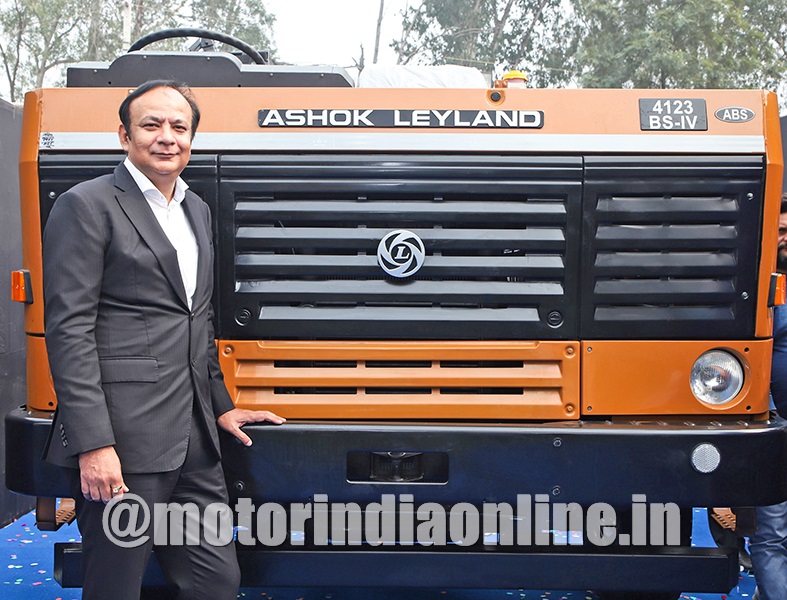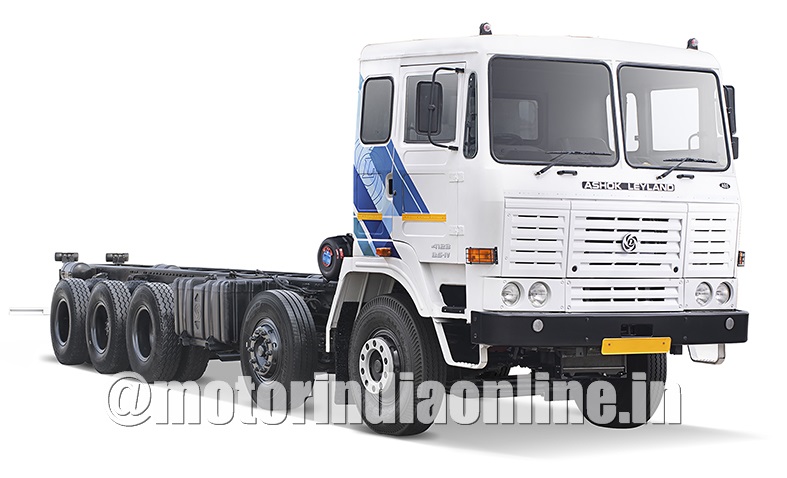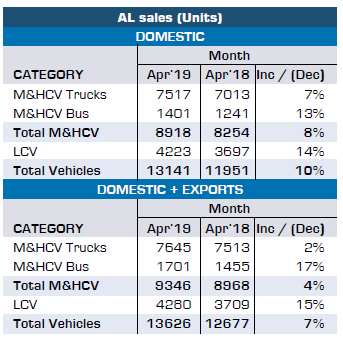16-wheeler 5-axle truck the new disruptor
Living up to its tag of being an innovator and a trend-setter in the Indian CV industry, Ashok Leyland had introduced a 16-wheeler rigid truck in 10×2 configuration – the 4123 – towards the end of 2018, a product that included patents and promised to deliver a unique value proposition for customers including much higher profitability. We met Mr. Anuj Kathuria, President – Global Trucks, Ashok Leyland, to get exclusive insights about the new product, along with updates on market sentiments, AL’s readiness for BS-VI, and more.

Excerpts:
How are the sentiments in the CV industry at present? What impact are the new axle load norms having on the market?
We have seen a dip in market sentiments since Q3 FY19 mainly due to liquidity crunch, axle load changes and rising fuel prices. The fuel prices have stabilized a bit and cash flow in the market is better; on the axle load side, July to October was mainly spent in understanding and adapting to the new norms, post which it starting reflecting on vehicle sales; now, we are seeing a different type of impact on the market, not on sales, but on the type of vehicles that are in demand; the sweet spot has shifted from 14-wheelers to 12-wheelers and also to 16-wheelers.
The hub & spoke model is maturing further, driven by GST; demand is shifting to ICVs on one side and higher tonnage vehicles on the other. We had anticipated most of this when the new axle load norms were announced. But, the rise in axle load capacity need not necessarily translate to reduced vehicle sales because the total demand in the market is not constant, it is growing. As road transport becomes more cost-competitive and efficient, as compared to rail, and with road infrastructure getting better, the demand for trucks is bound to go up.
How did AL conceive the idea of the 4123 16-wheeler truck? Where did the demand come from and how was the product developed?
AL was the first to introduce multi-axle vehicles (MAVs) in the country, the 2214 being our first MAV, which was a huge success. Around 2005-06, we felt 10-wheelers were also not delivering the required efficiency and productivity which is how the 12-wheelers were born. In 2014, we introduced a 5-axle truck which the industry readily accepted at a time when logistics models were changing, heavier loads were available and warehousing concept was catching up.
Throughout the above changes, overloading was highly prevalent in the market. More recently, driven by safety regulations and concerns over roads getting damaged faster, we saw the need to go beyond 37-ton which is why started working on a 41-ton vehicle (as per the old axle load norms). At AL, we try and study the market much closer than our competitors and understand the customer requirements better. We decided to have a twin-tyre lift configuration which is how the country’s first 16-wheeler, our 4123 was conceived. We tried to understand more about the configuration through prototyping, concept validation and realized it was not that straightforward. Using our innovative engineering approach, we have come up with certain patented technologies on the 4123.
The twin-lift was the main challenge and ensuring the tyre wear was minimal was a major consideration. The entire lift-axle configuration is a unique one and has been designed and developed indigenously along with our supplier partner Wheels India. In our configuration we have a straight lift where the axle goes 90 degree up, thereby ensuring least possible tyre wear.
From an engineering angle, are there any stand-out changes that have been incorporated in the vehicle? How do they benefit fleet customers?
One important feedback we received from customers during our market study was that they wanted us to reduce the number of times the truck visits the workshop and the amount of time spent during a scheduled maintenance visit. Taking cue from this, we brought in some unique features while configuring the vehicle. We have made unitized bearing a standard fitment. Regular hub bearings need to be greased every 80,000 km and replaced every 2.5 years; in our case, the unitized bearing need not be hub greased for five years which eliminates multiple workshop visits.
The suspension is another aggregate that has been significantly improved. The standard suspension that was used called for high level of maintenance and had to be greased at 30-odd points which was a pain-point for customers; the bushes had to be changed every 50,000 km, else there was a possibility of the casting getting damaged. In the 4123, we have introduced a slipper-ended suspension which comes with a simpler, more effective design that has only two greasing points and does not require any bush change at all. Through such innovative modifications to the vehicle, we have been able to drastically cut down on the maintenance cost and service time for our customers.
Also, all ball joints in the vehicle have been sealed for life, best-in-class tyres are fitted, driver comfort has been enhanced thanks to our offering of cable gear shift which is a standard feature in passenger cars.
Our vehicle offers a payload advantage of nearly five tons. From 42- to 47-ton GVW (as per new axle loads norms), the unladen weight of our vehicle has increased only by 300 kg which is quite a remarkable feat especially considering the improved vehicle configuration as explained earlier. On the fuel efficiency side too, there is only a negligible drop despite the higher tonnage. What else can a customer ask for! This is a product that has been truly engineered with the customer in mind. We have been selling the truck since December 2018; the market feedback has been excellent and we have a very good order book for the coming months.
We are less than a year from BS-VI. How prepared is AL for the transition?
Our BS-VI programs are on track; all our engines across the range – 40 to 400 hp – have cleared the test bed trials and we are fully confident of being ready for April 2020.
While leapfrogging from BS-IV to BS-VI in three years is quite a challenge, especially since no other country in the world has attempted it, the upside with BS-VI is that it gives us an opportunity to address other global markets which were not earlier addressable.
We are working on a new platform for BS-VI which will give us added capability to address more markets including both RHD and LHD countries. We will have a comprehensive portfolio right from the beginning and since it will be a modular platform, our ability to churn our variants will be much better and with greater efficiency.
Any new activity on the sales & service front?
We constantly keep preparing our network for the growing vehicle parc; we look couple of years ahead and expand our presence based on the expected vehicle parc. Our objective is to have a service touchpoint at every 50 km; today we are at 75 km and are working on filling gaps and also improving the quality of the services that we deliver.
The number of AMCs we give out is one of the highest in the industry and is becoming increasingly popular with long-haul and tipper customers. Our innovative support solutions such as Workshop on Wheels and containerized workshops are very well received.
On the training side, we have involved our core service team right from the development of our BS-VI platform; so the core team has already been trained and it’s just a matter of horizontally deploying it on to the field; we are on track and will be ready before the actual D-Day next April.
Your thoughts on how the industry will fare in FY19-20 and AL’s preparedness for the same?
Typically, in a year that precedes an emission change, pre-buy is definitely going to be a factor; how much it would translate into volumes remains uncertain considering other headwinds like the elections, carry-over impact of axle load norms, fuel prices, world economy, input material cost, etc. – there are so many factors that need to be taken into account. FY19-20 will be a challenging year because there can be so many different scenarios based on how the above factors pan out.
At AL, while we prepare ourselves for the market dynamics, one of our key focus areas is to make our organization more responsive and more nimble-footed. It does not matter how prepared we are, what matters is how well we can respond and who is able to respond the fastest and the best. We are enhancing our capability in this regard and it gives us a lot of confidence heading into the future.

